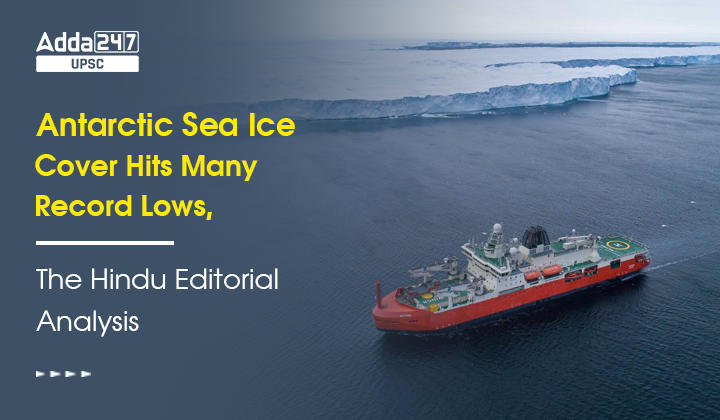Table of Contents
The Hindu Editorial Analysis: The Editorial Analysis of The Hindu Newspaper Editorial Articles aimed at simplifying various concepts relevant to the UPSC and other State PSC Exams. The Editorial Analysis helps in expanding the knowledge base as well as framing better quality mains answers. Today’s Hindu Editorial Analysis of ‘Antarctic sea ice cover hits many record lows’ discusses decreasing ice cover in Antarctic sea ice cover over period of time. Antarctic Sea Ice Cover Hits Many Record Lows article is analysed in detailed.
Antarctic Sea Ice Cover Hits Many Record Lows in News
A recent report indicates that the extent of sea ice in Antarctica has reached its lowest recorded level. The concerning trend continues, as global temperatures rise, leading to a reduction in sea ice cover.
Antarctica Ice Cover Status
Antarctica experiences a cycle where sea ice melts during its summer season, occurring from approximately October to March, and subsequently freezes again during the winter months.
- Although ice sheets in Antarctica undergo seasonal melting every summer, the extent of the record-breaking drop observed this year surpasses previous minimum levels.
- Specifically, on February 19, 2023, the Antarctic sea ice extent reached a historic low of 1.76 million square kilometers.
Decline of Antarctic Sea Ice Cover Trends
Over the past six years, data reveals significant declines in the coverage of Antarctic sea ice. This accelerated melting of sea ice contributes to the elevation of global sea levels, presenting a significant risk to coastal cities.
- NASA reports that approximately one-third of the overall global sea level rise observed since 1993 can be attributed to the meltwater originating from the Antarctic ice.
- With the exception of March and April, the sea ice extent throughout this year has consistently remained at its lowest recorded levels.
- To illustrate, on May 20, the recorded ice extent of 8.73 million square kilometers marked the lowest ever observed on that particular date since 1950.
- On numerous occasions, the sea ice extent dropped significantly below the levels observed in 2022, which held the record for the second-lowest summer sea ice extent in Antarctica.
Impact of Reduction in Ice Cover
The substantial reduction in ice cover has far-reaching consequences, impacting global weather patterns and underwater ecosystems.
- The Southern Ocean, identified as a vital conduit for heat transfer from the atmosphere to the world’s oceans, plays a crucial role in this context, as outlined in a report by the Intergovernmental Panel on Climate Change.
- Scientists explain that the increased influx of cold, fresh water resulting from ice melt disrupts the circulation patterns of hot, cold, fresh, and salty water across the globe.
- Such changes in temperature and density can subsequently influence weather systems and alter the distribution of nutrients in deep waters.
- The repercussions extend beyond nutrient flows, as algae thriving on the sea ice serve as a source of sustenance for smaller crustaceans like krill, which in turn support the survival of whales, seals, penguins, and other bird species.
- The diminishing sea ice translates to a reduced availability of food to sustain the Antarctic food chain.
- The visual representation provided shows the extent of sea ice as of May 21, with the boundary line indicating the median sea ice extent between 1981 and 2010.
- Comparatively, the current sea ice extent has significantly diminished in relation to the historical median.
Rising Global Temperature and Anomaly in Antarctica
As global temperatures continue to rise, the Antarctic region has experienced elevated air temperatures this year. The reduction in sea ice coverage contributes to a greater absorption of the sun’s heat by the darker-colored ocean, as less of it is reflected back. This phenomenon is known as the ice-albedo feedback cycle, where heat becomes trapped.
- Over the years, notable temperature anomalies have been observed in Antarctica. Chart 3 presents data on global temperature anomalies specific to the Antarctic region.
- In 2023, the April temperature in the Antarctic region was 0.93°C higher than the average for that month between 1910 and 2000, representing the second-highest increase recorded in centuries.
Conclusion
While ice does regenerate during the winter months, the newly formed ice tends to be thinner compared to the multi-year ice, resulting in a more delicate and vulnerable state for the overall surface area of Antarctica.
India’s 41st Scientific Expedition to Antarctica



 TSPSC Group 1 Question Paper 2024, Downl...
TSPSC Group 1 Question Paper 2024, Downl...
 TSPSC Group 1 Answer key 2024 Out, Downl...
TSPSC Group 1 Answer key 2024 Out, Downl...
 UPSC Prelims 2024 Question Paper, Downlo...
UPSC Prelims 2024 Question Paper, Downlo...




